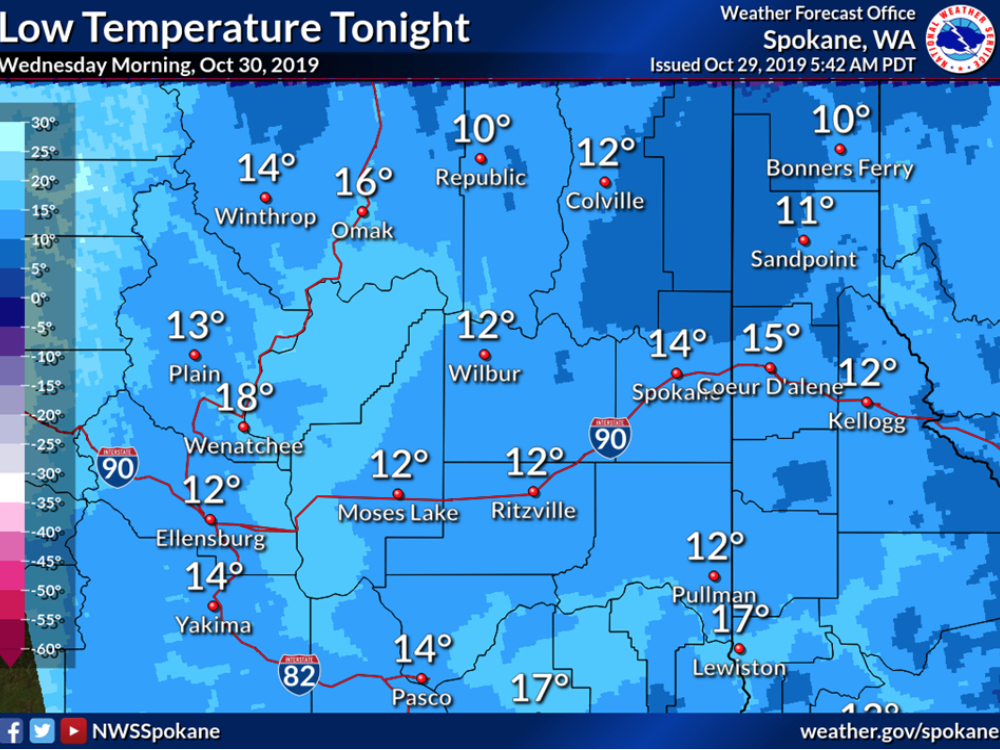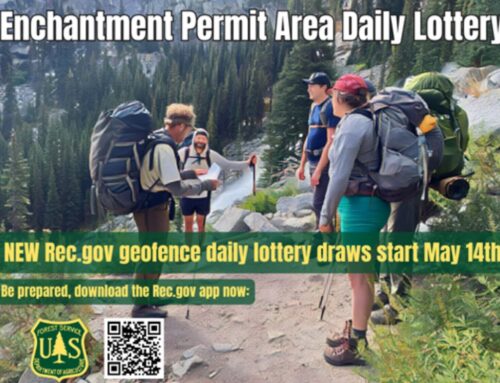NWS Issues a Hazardous Weather Outlook; Red Cross Offers Safety Tips
Information and graphics released by NWS-Spokane
Another cold night is in store tonight into Wednesday morning. Widespread low temperatures in the teens are expected, with some spots reaching into single digits.
The National Weather Service has issued a Hazardous Weather Outlook is for portions of North Idaho…North Central Idaho…Central Washington…East Central Washington…North Central Washington…Northeast Washington and Southeast Washington.
Day One: Tuesday and into Wednesday morning
Unseasonably cold temperatures are expected today and tonight. Wind chill values will drop into the single digits and teens. Some icy patches are possible on area roadways in the morning.
Days Two through Seven: Wednesday through Monday
Unseasonably cold temperatures are expected through much of this week. Wednesday will likely be the coldest day.
Safety Tips from the American Red Cross
As unseasonably cold temperatures move across the Pacific Northwest, the American Red Cross has compiled some safety tips that will help you prepare yourself, your home and your pets for what is likely only the first of many cold days and nights ahead this winter.
Temperatures will be below freezing in many locations with wind chills making it feel even cold in some areas. Learn what to do if the power goes out and how to heat your home safely here.
Take immediate precautions if you hear these words on the news:
- Winter Storm WARNING: Life-threatening, severe winter conditions have begun or will begin within 24 hours.
- Blizzard WARNING: Sustained winds or frequent gusts of 35 miles per hour or greater, plus considerable falling or blowing snow reducing visibility to less than a quarter mile, expected to prevail for three hours or longer.
- WIND CHILL Temperature: How cold people and animals feel when outside. As wind increases, heat is carried away from your body at a faster rate, driving down your body temperature and making you feel much colder. The wind chill temperature is not the actual temperature but rather how wind and cold feel on exposed skin.
- Winter Storm WATCH: Winter storm conditions possible within the next 36 to 48 hours. Review your winter storm plans and stay informed about weather conditions.
WHAT YOU SHOULD DO
- Assemble an emergency preparedness kit. Full details here.
- Protect pipes from freezing.
- Caulk and weather-strip doors and windowsills to keep cold air out. Install storm windows or cover windows with plastic from the inside to provide an extra layer of insulation to keep cold air out.
- Make sure you have enough heating fuel on hand. Conserve fuel. Winter storms can last for several days, placing great demand on electric, gas, and other fuel distribution systems (fuel oil, propane, etc.). Lower the thermostat to 65° F (18° C) during the day and to 55° F (13° C) at night. Close off unused rooms, and stuff towels or rags in cracks under the doors. Cover the windows at night.
- Stay indoors and wear warm clothes. Layers of loose-fitting, lightweight, warm clothing will keep you warmer than a bulky sweater. If you feel too warm, remove layers to avoid sweating; if you feel chilled, add layers.
- Check on relatives, neighbors, and friends, particularly if they are elderly or if they live alone.
STAY SAFE OUTSIDE
If you must go outside, protect yourself from winter storm hazards:
- Wear layered clothing, mittens or gloves, and a hat. Outer garments should be tightly woven and water repellent. Mittens or gloves and a hat will prevent the loss of body heat.
- Cover your mouth to protect your lungs from severely cold air. Avoid taking deep breaths; minimize talking.
- Watch for signs of hypothermia and frostbite.
- Keep dry. Change wet clothing frequently to prevent a loss of body heat. Wet clothing loses much of its insulating value and transmits heat rapidly away from the body.
- Stretch before you go out. If you go out to shovel snow, do a few stretching exercises to warm up your body. This will reduce your chances of muscle injury.
- Avoid overexertion, such as shoveling heavy snow, pushing a vehicle, or walking in deep snow. The strain from the cold and the hard labor may cause a heart attack. Sweating could lead to a chill and hypothermia.
- Walk carefully on snowy, icy sidewalks. Slips and falls occur frequently in winter weather, resulting in painful and sometimes disabling injuries.
- If you must go out during a winter storm, use public transportation if possible. About 70 percent of winter deaths related to ice and snow occur in automobiles
WINTER DRIVING SAFETY
Stay off the road if possible during severe weather. If you must drive in winter weather, follow these tips:
Keep in your vehicle:
A windshield scraper and small broom. A small sack of sand for generating traction under wheels and a set of tire chains or traction mats. Matches in a waterproof container. A brightly colored (preferably red) cloth to tie to the antenna. An emergency supply kit, including warm clothing.
- Keep your vehicle’s gas tank full so you can leave right away in an emergency and to keep the fuel line from freezing.
- Make sure everyone has their seat belts on and give your full attention to the road.
- Don’t follow other vehicles too closely. Sudden stops are difficult on snowy roadways.
- Don’t use cruise control when driving in winter weather.
- Don’t pass snow plows.
- Ramps, bridges and overpasses freeze before roadways.
If you become stranded:
- Stay in the vehicle and wait for help. Do not leave the vehicle to search for assistance unless help is visible within 100 yards (91 meters). You can quickly become disoriented and confused in blowing snow.
- Display a trouble sign to indicate you need help. Hang a brightly colored cloth (preferably red) on the radio antenna and raise the hood after snow stops falling.
- Run the engine occasionally to keep warm. Turn on the engine for about 10 minutes each hour (or five minutes every half hour). Running the engine for only short periods reduces the risk of carbon monoxide poisoning and conserves fuel. Use the heater while the engine is running. Keep the exhaust pipe clear of snow, and slightly open a downwind window for ventilation.
- Leave the overhead light on when the engine is running so that you can be seen.
DOWNLOAD APPS People can download the Red Cross Emergency App for instant access to weather alerts for their area and where loved ones live. Expert medical guidance and a hospital locator are included in the First Aid App in case travelers encounter any mishaps. Both apps are available to download for free in app stores or at redcross.org/apps.
Winter is also hard on our pets. Visit here to learn how to keep your furry friends safe during this cold, snowy weather.








